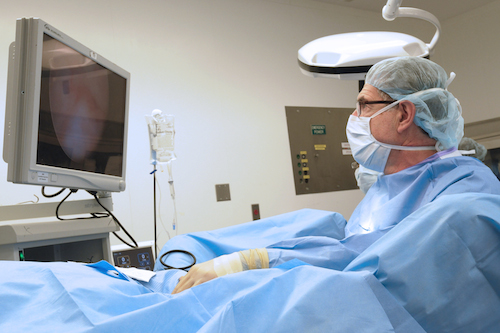Stony Brook lighting the way for better bladder cancer detection
Wednesday, February 19 2014 1:13 pm
by RiverheadLOCAL

Wayne Waltzer, MD, Chairman, Department of Urology, Stony Brook Medicine in an operating room at Stony Brook University Hospital.
Stony Brook University
Hospital is the only institution on Long Island to offer a new imaging agent
for the detection of papillary cancer of the bladder in patients with known or
suspected bladder cancer.
Bladder cancer is the sixth most commonly diagnosed cancer in the United
States. According to The National Cancer Institute nearly 73,000 new cases of
bladder cancer are diagnosed in the U.S. each year. Wayne Waltzer, MD,
Chairman, Department of Urology, Stony Brook Medicine says bladder cancer can
sometimes be difficult to detect.
“Bladder cancer is the type of cancer that can also get aggressive and
metastasize quickly. So making an accurate diagnosis is key,” said Waltzer.
“The Blue Light Cystoscopy with Cysview is important because it’s a modality
that is proven to make more sensitive diagnoses. We are able to find smaller
tumors that may have been undetected.”
Photo Caption: Left, bladder image using white light
cystoscopy alone. Same image on the right after using Blue Light Cystoscopy
with Cysview as an adjunct to white light. The blue light causes compounds
within the tumors to fluoresce a pink color, providing specific and accurate
visualization of tumors.
Since bladder cancer has a very high recurrence rate – between 50-80 percent –
it requires life-long surveillance and is one of the most expensive cancers to
treat, with nearly 40 percent of the costs coming from surgical interventions
to treat the recurrence.
“Using this new diagnostic tool enhances our ability to do surgery, if needed,
and remove the tumors right away,” said Waltzer. “Better detection translates
to earlier treatment and results in a decreased rates of recurrence.”
White light cystoscopy had been has been the gold standard for visualizing
suspicious lesions during transurethral resection of bladder tumor (TURBT).
However, when used on its own, harder-to-see tumors can often be missed.
Cysview works by exploiting fluorescent properties of naturally occurring
molecules in malignant tissues. Cysview is the only FDA-approved imaging agent
for use with blue-light cystoscopy.
Using Blue-Light Cystoscopy with Cysview, the imaging solution is
delivered into the bladder about an hour prior to the cystoscopy and is
absorbed by cancerous tissue. Using the special Photodynamic Diagnostic system,
the doctor inserts a long thin scope into the bladder. After first using white
light, the doctor will switch to blue light mode. Because of the preferential
uptake of Cysview by malignant cells, hard-to-see tumors that may be present
become more visible, standing out against normal bladder tissue and making it
easier for the doctor to identify and remove them.
“At Stony Brook Medicine, patients with known or suspected bladder cancer can
now get the answers they are looking for and the care they need,” said Waltzer.

